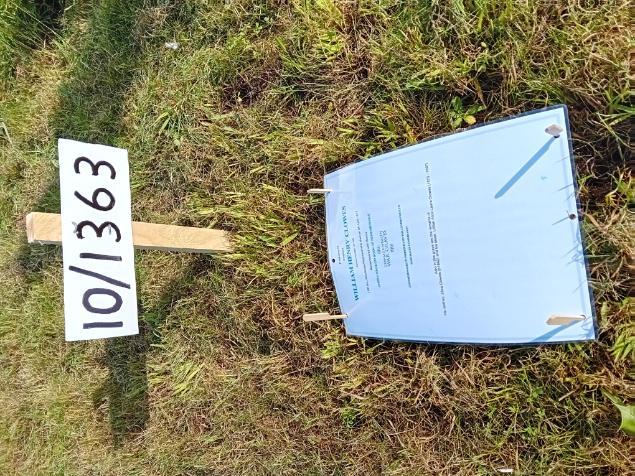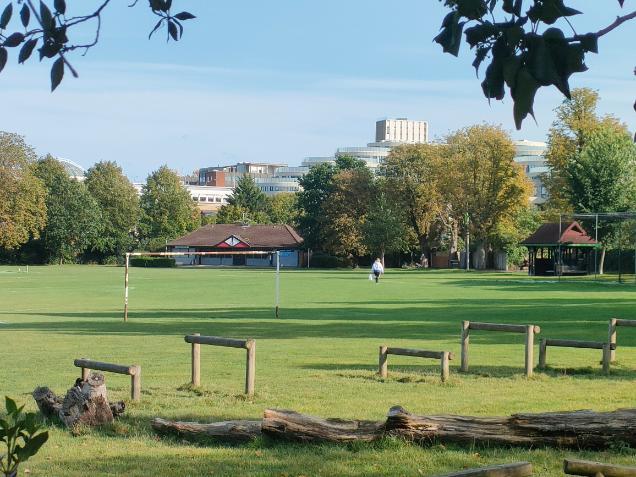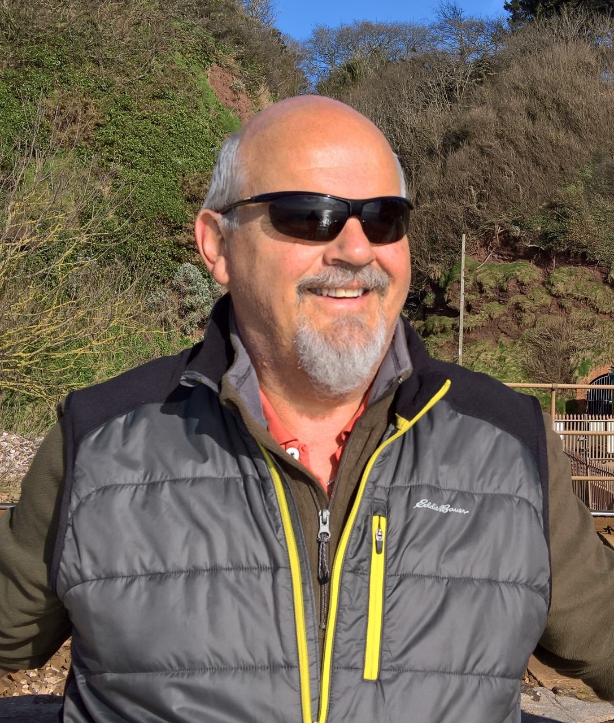No Stone Unturned...
06/11/2023 - 4.19
Roger Slater
Many of you reading this will know that I’ve been researching the history of Wealdstone FC since the late 1990s, whether it be through old documents or newspapers, on microfiche or more recently on the internet. A long enough task in its own right, but understand two things: firstly, it is incredibly easy to get side tracked when you find something that piques your interest and valuable hours are lost diving into a rabbit hole, following the warren of threads that lay hidden below. Second, is the existence in the darkest corners of my mind, the mental filing system that remembers unusual facts from the intended (and unintended) research and the rabbit holes that I’ve dropped into, recalled with far greater clarity than they are due, triggered by something (often completely un-associated) that I come across.
And that, with a satisfying end, is the perfect introduction to William Henry John Clowes, a name that will mean very little to anyone let alone Wealdstone FC, long forgotten, though he did play a very small part in the club history before losing his life as a result of gassing on The Somme in The Great War.
With a loose historical timeline, let me explain: When I started to research the club in the late 1990s the records of The Harrow Observer and The Harrow Gazette (on microfiche) were invaluable. I started with the newspapers from 1899 (the perceived year of foundation). Viewed on a big old CRT screen with the definition and resolution of charcoal, I read the ‘first’ match report. Without going through the whole history, that “first” match report informed me in black and white that “…the club wore the same colours” and later “…the club used a number of the same players”. Not the first match then. Down the rabbit hole of preceding years I went, eventually uncovering seven or eight associated clubs that were in fact related to the history of ‘the first’ Wealdstone FC and with various name changes and mergers, the current club. One linked preceding club was Harrow Athletic, with whom ‘the first’ Wealdstone FC had merged in 1894. Let me add here that the links between first and current Wealdstone FC are very strong with continuity of players and officials in both clubs, and as more detail has come to light, the history of The First Wealdstone FC (1883-1895) was published a couple of years ago (and can be purchased from http://wfcmegastore.co.uk if you are interested!) But let’s not dwell!
In 2016, the impending 100th Anniversary of the Great War Armistice focussed the mind on those players and officials that Wealdstone FC had lost in both World Wars. I had a list of names but little else, so I researched their war history and in some cases their families to add some detail to each name. It was back to the newspapers, thankfully an electronic copy of all issues from 1914-1919 initially, which made the process much easier. Among enlistment records of all those that joined up in Harrow in the early days and weeks of war, I found many names I recognized from the squads of 1912, 1913 and 1914 and also some names that popped out from the page that I had come across and recognized from twenty years earlier. One, in fact two, were brothers - HW Clowes and WH Clowes, Harrow Athletic players from the mid-1890s, William Henry having been a player for the merged Harrow club when the first Wealdstone FC had joined. I have no idea why these two names stuck as they were two of twenty or thirty I had previously read, but once again, they popped from the page. Week by week, page by page, I religiously read the newspapers I had stored on a USB drive, looking for any mention of Wealdstone players, both those that fell in service and those that survived, adding to each personal history in preparation of the memorial for the match programme.
Back to William (known as “Tut”) Clowes, one of three children of William and Eliza Clowes and a Harrow Athletic player through the merger with Wealdstone in 1894, still playing at Harrow Athletic in 1900. A newspaper report from August 1916, mentioned that he had been severely gassed on The Somme on 4th May and had been invalided home to recuperate, at which point with a minor involvement as a player in the history of our predecessors, he would remain no more than a footnote in club history, one perhaps for the ‘to do later’ pile as I have an ongoing interest in The Great War and that was all.
Spring forward a couple of years and during one of Covid’s enforced lockdowns, I thought I would turn the information I had on our fallen from both wars into two booklets, one for each war, adding what I could ascertain from military and regimental diaries to the newspaper information. The additional information allowed me to construct a basic historical timeline of the service of the Wealdstone FC players throughout the wars. The timeline was also interspersed with ‘local’ information relevant to the club – the inception and building of RAF Northolt (in truth RFC Northolt when it opened in 1917), and the Gun Turret constructed in 1941, that stands in the corner of the ground, a constant reminder of the club’s part in both wars. Once again, up popped William Clowes.
I knew of his gassing and repatriation but once again his name popped from the pages of the local newspaper. He had served as a Sergeant with the Machine Gun Battalion of the 13th Middlesex Regiment and had joined up in September 1914, aged 36. He had fought in both Belgium and France prior to being invalided home. All this I gleaned from a later newspaper report (May 1917), an obituary that reported his death at home in Eastcote Road, Harrow. Since his repatriation, he had spent time in the Great Eastern Hospital in Cambridge, the Cottage Hospital in Hounslow and eventually in Mount Vernon Hospital in Northwood, where he resided for four months, all to no avail, as his condition slowly worsened until he was discharged home shortly before his death on 4th April 1917.

Source: Harrow Observer 20th April 1917
Back down a rabbit hole! Still little more than a footnote in the club history, something made me look at the Commonwealth War Graves Commission website to research him further, perhaps looking to see where he was buried – I really don’t know. Entering his name, age service number et all, I drew a blank. Quite simply, he wasn’t there. I knew a fellow Stones regular, Nathan Whitehouse (you will have come across the excellent @CFCGraves - Chelsea Graves Society which he runs on Twitter) volunteers with the CWGC so I mentioned William Clowes to him.
I added that I thought he should have been included on the database but wasn’t. Nathan took the information I had, as well as the press cuttings and approached his CWGC Supervisor, Janice Wilburn, the ‘Eyes on Hands on Coordinator (London)’ and she registered a Non-Commemoration case submission based on the information. There it sat for about 12 months until late April 2023, when Nathan received an email from Janice that included correspondence from James Wallis, Commemorations Policy Manager at the CWGC, which he forwarded to me…
“…Subject: FW: Adjudication - Non-Comm Submission for Sgt Clowes
Dear Janice,
I hope this finds you well.
I am contacting you with an update about a Non-Commemoration case submission. This was forwarded on to Commemorations by yourself in April last year, you having been notified by a EOHO Volunteer. I’m unclear whether you or the Enquirer were ever notified that the case had been logged, but its allocated reference number was NC 11598. The case pertained to G/1146 Sgt William Henry Clowes of the Middlesex Regiment, who died in April 1917.
I am pleased to relay that this casualty has been accepted for commemoration as a Commonwealth War casualty, following a recent adjudication decision from the military service authorities. A listing for him has now been created on the CWGC Casualty Database, which can be accessed via the following link.
Where applicable, we will now commence a ‘Grave Found’ investigation to see if we can identify and mark the original burial location for this individual.
Please let me know if I can clarify anything, otherwise my thanks for your help in forwarding on this message.
Kind Regards,
James Wallis”
They had been unable to find a grave, but William at least was remembered on their database and a search now brings up his Death Certificate in common with the others that served and sadly did not return.

Source: London Borough of Harrow Cemeteries
My search continued. Billiongraves.com, Find-a-Grave, Harrow Museum, Church records…I uncovered a family tomb at St Mary’s Harrow on the Hill where father, Grandparents and Brother were buried, but not William. I had drawn a blank. The Harrow Council Grave online search only goes back to 1923, so that was no use…except it lists an email address. I mailed through the details I had, name, date of birth, date and place of death and even some family details – his mother and sister’s details in addition to what I knew from the St Mary’s Tomb and waited. Timing is a marvellous thing, as my mail was read by a Customer Advisor (Melanie) with time on her hands. I didn’t get the expected ‘…sorry, our online records don’t go back that far’ that I expected. With no luck on the electronic records, she had in fact pulled out the volumes of the London Borough of Harrow Burials for April 1917 for each of the seven cemeteries and she searched the original hand-written notes and plans. More importantly, she found the correct grave! William Clowes was buried with his mother and sister, but the handwriting had been misread when the electronic records were created and the family had been recorded as Claves rather than Clowes. Melanie sent me the details, a copy of the log and even a map to the location of William Clowes, plot 10/1363, in what was originally Pinner Old Cemetery, but is now known as Harrow Cemetery, and she also updated the online record so any search in the future will find the correct location.
Having forwarded the information on the location to the CWGC so that the process can start to install a new headstone on the grave, I visited the site with a few ‘Stones fans before a recent match v Woking. Melanie had contacted the groundskeeper responsible for the cemetery - he had placed a marker on the plot and cut the grass for our visit and I added a copy of his CWGC Certificate (below).

Source: Author’s collection
If you know the cemetery, it is at the rear of Harrow Rec near Roxborough Road. William’s grave faces the Rec and the two football pitches (below) that he would have played on for Harrow Athletic in the 1890s. I shall return to the graveyard once the new headstone is installed.

Source: Author’s collection
William Clowes remains a footnote in the history of Wealdstone FC, but he can now be properly remembered and recognized for his service and the life he gave for his country. This stone most definitely turned 106 years after his death.
I’ve also now been able to do some further research into William’s family in the hope of finding a relative or descendant that I can advise of the progress. What I have found is that William, a plumber before war broke out in 1914, had previously served in the Middlesex Regiment – he had joined up around 1904 and had served for three years. When he left, presumably to take up his trade he was placed on reserve, and he was therefore called up at the age of 36 years 6 months on September 3rd 1914, and was posted to France in October 1914. He was made up to Acting Corporal three weeks later and full Corporal in January 1915, before once again being promoted to Sergeant on 11th March 1915. Serving along the Western Front he was gassed and eventually discharged unfit for further service on 30th August 1916.
As mentioned in the newspaper cutting, he spent time in a number of hospitals, eventually being discharged from Mount Vernon Hospital in Northwood a matter of days before his eventual death, unmarried and without children, at 21 Eastcote Road, the home of his older brother James Keeling Cowes and his wife, Agnes.
Another older brother, Horatio (d1948) married Alice Smith (d1955) and they had one child, a daughter, Ruby Alexandria Smith (d1953) who married Edward Robert Worms (d 1974) in 1948, however they had no children.
William also had a sister, Lillian Alice Clowes born in 1873, but she sadly died unmarried and without children in 1897. Another line of descendants closed.
So back to James Keeling Clowes, the last of the direct family. In 1894, he had married Agnes Rhoda Allen and they had two children, in 1898, Marjorie Celia Clowes was born and four years later, James (Jim) Richard Clowes followed. Jim (d1981) married Gladys Ethel Evans (d1983) in 1931 and their marriage was another without children. Another closed door. The last line to follow was Marjorie Celia Clowes (d1989).
She had married Edward Joseph Hart (d1973) in 1919 and they had had a daughter Carnella Lily Broni Hart (d2010) in 1921. Carnella had married Peter John Keppey (d1992) in 1940 and they had a son, Peter Andre Keeling Keppey (d2005). Though access to the records is limited, it seems that Peter married Brigid J Mangan in Harrow, Middlesex in 1968 but nothing else is availably publicly. If Brigid is still alive, she’d likely be mid to late eighties and I can find no details of any children to follow up either.
I have found a distant cousin, (second or third cousin four times removed I believe), Gerald McCaughey living in Perth, Western Australia and I’ve been in contact but sadly they only know of the Clowes family as a name on their ancestry tree, but I’ll keep looking!
Meanwhile, William, along with those players and officials more closely associated with Wealdstone FC that lost their lives in the two great wars will now be remembered when the whistle blows…
Biography
Roger Slater was born in Harrow in the late 1950s and has moved around a bit and retired to Devon with wife of 24 years, Helen. He originally trained as an Electrical Engineer but worked for almost 40 years in Building Services Technologies, primarily HVAC control systems and Electronic Security. Roger retired in 2018 having run his own Engineering Consultancy for almost 15 years.
For relaxation and hobbies, he writes, mainly about his football club, Wealdstone FC and has published eight books including a club history since 2002. He does not class himself as a historian, just an enthusiastic amateur.
He also writes for a fanzine/magazine called Where’s The Bar that has just relaunched.
Otherwise, hobbies are upcycling and building ‘strange’ lighting out of people’s rubbish and occasionally painting, though he also buys and sells at auctions and on the internet (mainly football related or antiques).
In respect of other sports, he will watch most but follows the Toronto Blue Jays avidly in baseball, as a result of working on and off in Canada in the early nineties.
Roger also reads and collects books on World War One, in particular personal biographies and war diaries as opposed to battle histories…
All of that could change tomorrow or on any other day if something else takes his fancy as he will give most things a try if they appeal!!



/prod01/wlvacuk/media/departments/digital-content-and-communications/images-2024/Simmi-Sahota-degreeshow-thumbnail.png)
/prod01/wlvacuk/media/departments/digital-content-and-communications/images-2024/250630-SciFest-1-group-photo-resized-800x450.png)
/prod01/wlvacuk/media/departments/digital-content-and-communications/images-18-19/210818-Iza-and-Mattia-Resized.jpg)
/prod01/wlvacuk/media/departments/digital-content-and-communications/images/Maria-Serria-(teaser-image).jpg)
/prod01/wlvacuk/media/departments/digital-content-and-communications/images-2024/241014-Cyber4ME-Project-Resized.jpg)
/prod01/wlvacuk/media/departments/digital-content-and-communications/images-18-19/210705-bric_LAND_ATTIC_v2_resized.jpg)